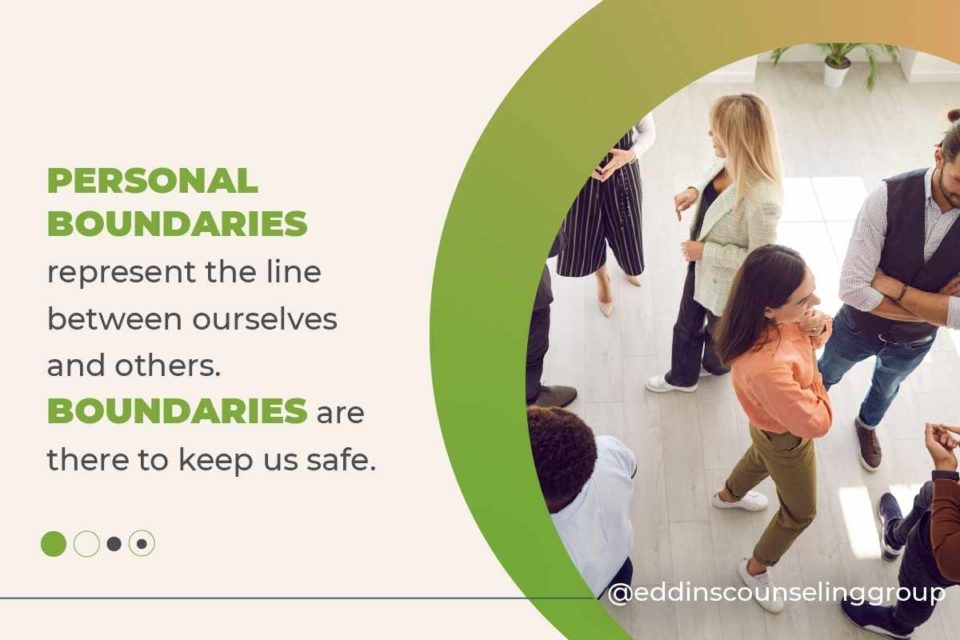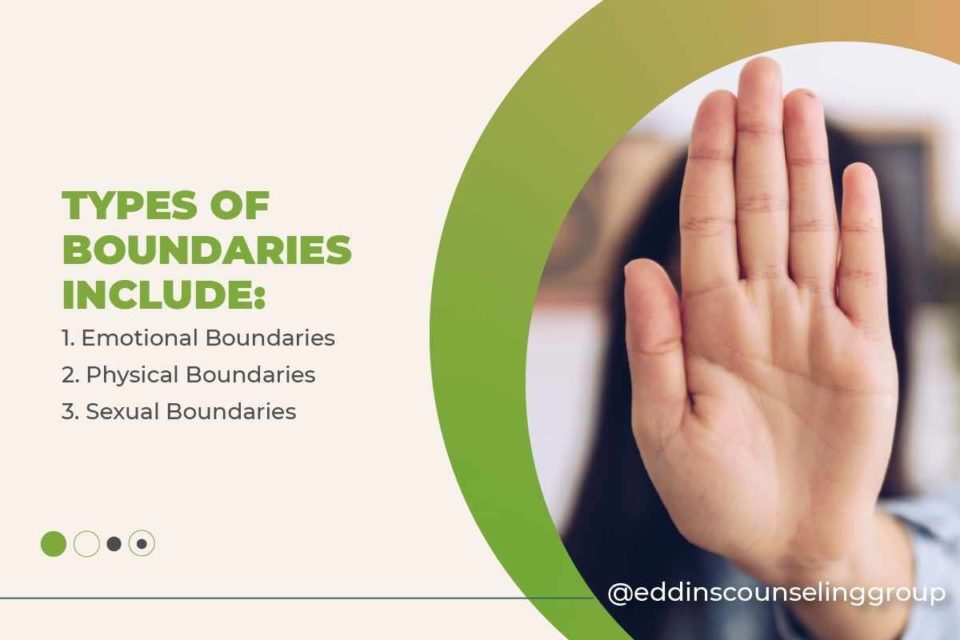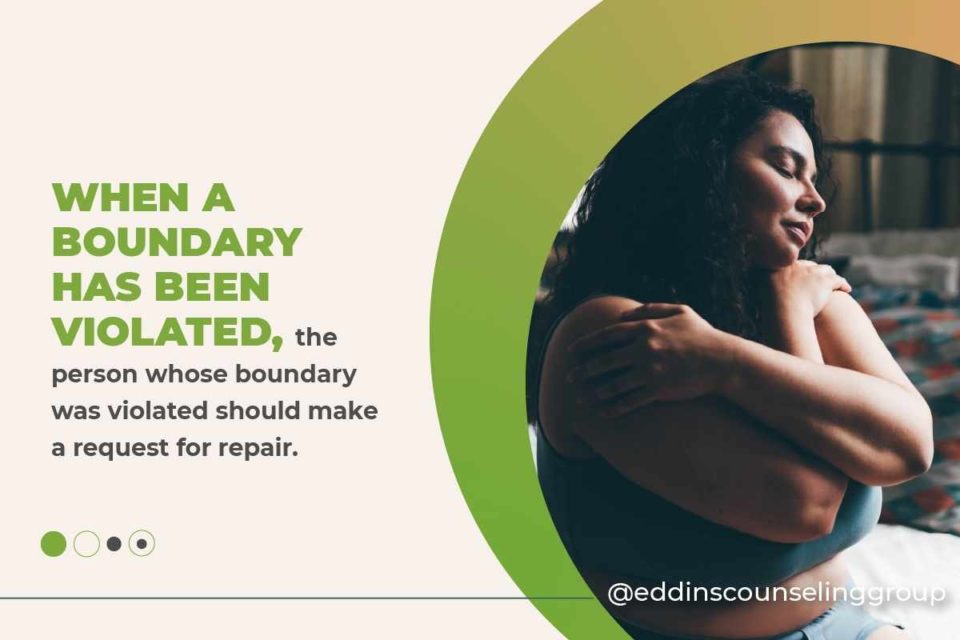April 26, 2020
How to Set Healthy Relationship Boundaries
Written by Rachel Eddins
Posted in Relationships, Couples, Marriage and with tags: Communication, boundaries, emotional health, self care
 Do you have a hard time standing up for yourself? Do you agree to things you don’t want to do? Do you take things personally that might not be personal?
Do you have a hard time standing up for yourself? Do you agree to things you don’t want to do? Do you take things personally that might not be personal?
You may benefit from learning how to set personal boundaries in relationships. Learning how to set healthy relationship boundaries can also help you increase your self-esteem and self-confidence (or vice-versa!)
Steps to Setting Healthy Relationship Boundaries & Improve Your Self-Esteem
What steps can you take to improve your self-esteem? This is the first step in working towards healthy relationship boundaries, believing that you are worth it!
Setting personal boundaries comes from:
- valuing yourself,
- knowing your limits, and
- being willing to accept the outcome that may occur as a result of setting the boundary.
Ultimately, boundary setting is an act of self-care and self-protection.
Go through the following steps to remind yourself first, that you are valuable and deserving of respect. Once you have a healthy sense of self-worth, you can begin to establish healthy boundaries with others.
How to Develop Healthy Boundaries:
1. Believe in yourself.
Identify your strengths. Trust and know that you are worthwhile. Treat yourself as if you are through good self-care. Consider your strengths as unique to you and give yourself credit for who you are. That can be challenging when you feel that you aren’t measuring up, so take some time to list out your strengths.
(Read this article to identify your work-related strengths).
Rather than beating yourself up, practice self-compassion or forgiveness.
Compassionate letter writing is one exercise you can practice to increase your own self-compassion.
2. Support your well-being through positive self-care.
Self-care doesn’t mean the one-time good things you do to treat yourself such as a massage. Self-care is the way you treat yourself on a regular and consistent basis. Things such as eating a balanced diet, getting enough rest, taking time out for rest and play, finding positive and healthy sources of pleasure, and actively pursuing your goals are all aspects of good self-care.
Give yourself positive affirmations. Write them down if you need to as a reminder. Try, “I am a unique and valuable person. I am worth the effort it takes to advocate for myself and get what I need for myself.” Come up with your own affirmations.
Self-care is a relationship boundary between you and yourself. It’s hard to expect others to treat you well when you aren’t treating yourself well.
We typically learn how to treat ourselves based on how others have treated us in the past. Don’t blame yourself if this is a challenging area for you. It simply means this is a skill you weren’t taught naturally. If you were told you weren’t good enough (or it was implied) when you were growing up, you may struggle with self-care. Reach out to a mental health counselor if you struggle with self-care.
3. Set goals for yourself.
Rather than deciding that you aren’t worth it, or your dreams aren’t worth it, identify areas where you would like to make improvement in your life that relate to a positive outcome in how you feel. For example, weight loss isn’t a healthy goal per se if the positive outcome is tied to judgment and short-lived results (feeling better in one moment at the pool or the upcoming wedding). Rather, feeling good in my body, increasing energy and overall health are goals worth striving for.
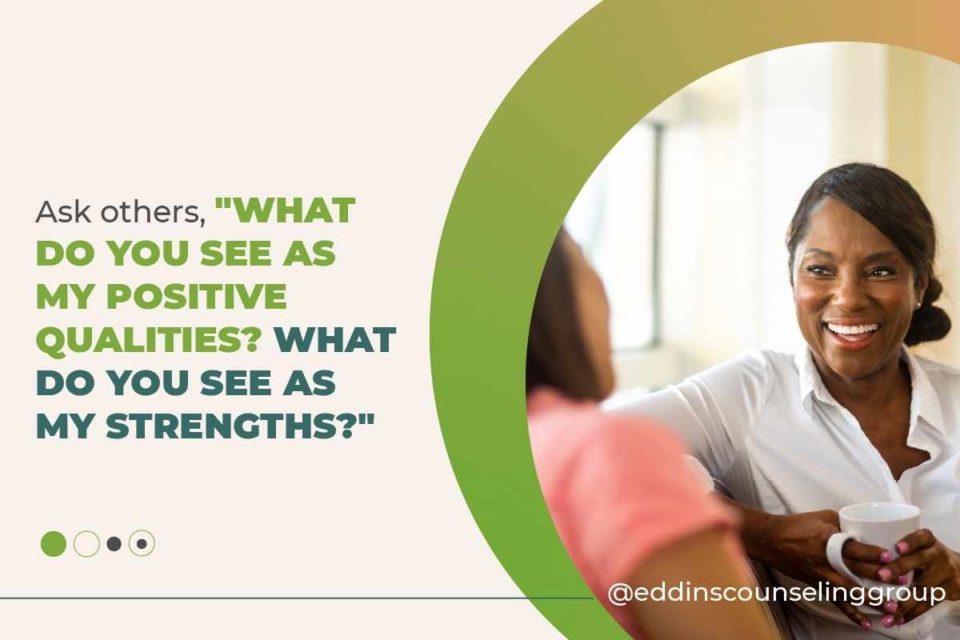
4. Get feedback from others.
Develop a comprehensive list of your strengths to review often.
Reach out to a few trusted friends who love you and know you well. Ask them for their feedback on your unique strengths. Ask, “what do you see as my positive qualities? What do you see as my strengths? How would you describe me?” Do this exercise with at least three people who know you well and support you to develop a good list.
Once you have a good list, your next step is to OWN it! Sometimes, we take our strengths for granted, assuming that these come naturally to everyone or they aren’t anything special. That is far from the truth! We all have our own unique personalities and strengths, so be sure to claim yours.
Add additional strengths you identified for yourself in step 1. Keep this list handy in a journal or electronic device and review it each night before you go to bed. Add new things to it as you identify them.
5. Get support.
If you have completed steps 1-4 and still are struggling with feeling worthy, ask those you love and trust to remind you. A therapist can also help you identify your core beliefs and change negative beliefs about yourself and build self-confidence.
Support groups are another great way to build support and positive self-worth. Often, members in a group feel similarly. It can be validating to learn that you are not alone while also learning strategies that have worked for others like yourself.
6. Identify what matters to you.
Knowing your values, what matters to you in each area of your life, is important for living a life that you value. This worksheet can help you identify your values.
7. Identify your needs.
In order to begin setting healthy relationship boundaries, you have to know what it is that you need in the first place. This list of feelings and needs can help you get started.
Review this list of needs and prioritize what is important to you. Which needs are not currently being met in your life? What steps can you take to begin to meet those needs on your own?
It may be challenging to identify your own needs if you have been focused on the needs of others.
8. Know the consequences of unhealthy boundaries.
Unhealthy boundaries can lead to feelings of emptiness and un-fulfillment. What have you sacrificed for your own well-being by focusing on others? Conversely, what have you missed out on in relationships by protecting yourself?
9. Strengthen your internal boundaries.
An internal boundary is a line between a comment from another person and you taking it in as true about you. When are internal boundaries are weak, we may take things personally more often. When someone makes a negative comment about you, stop and ask yourself the following:
- How much of this is true about me?
- How much of this is about the other person?
- What do I need to do (if anything) to stand up for myself?
What are Healthy Relationship Boundaries?
Personal boundaries represent the line between ourselves and others. We don’t want the line to be too close or we can alienate others and feel alone. Nor do we want the boundary to be too far out, or we can find ourselves focusing on others’ needs, saying yes to things we don’t agree with, and not getting our needs met.
Boundaries are also there to keep us safe.
Relationship boundaries are flexible, there is no black and white answer to what a healthy relationship boundary looks like. Sometimes we need to be more flexible and allow more space, and sometimes we need to reign it in tighter to protect ourselves.
Setting a boundary with others simply means being clear about making choices that support your own well-being, in line with your values and needs (from steps 6 & 7 above). They also need to be visible and communicate with others. It’s not enough to expect others to “just know.”
Healthy Relationship Boundaries Begin with Awareness
Since boundaries are there to protect us, take some time to think about when you last felt “unsafe” or not protected in a relationship with someone else.
Examples might be, being forced or coerced to do something you didn’t want to do, sharing vulnerable details about yourself and being judged or criticized, having someone else make choices or decisions for you when you are capable of making them on your own.
Other examples might include a partner or family member who is using drugs, abuses you or is having an affair.
Consider examples of when you didn’t protect yourself as well. Those examples might be, agreeing to do something you didn’t have time to do, spending so much time on other’s needs, you had no time left for your own self-care, sharing personal details about yourself with someone you didn’t trust or know very well, apologizing for saying “no”, or relying on others instead of yourself.
Boundaries can occur within every aspect of our lives. Physical, sexual, spiritual, relational, emotional, mental, legal and more.
Ways to identify when your boundaries have been crossed:
- Situations in which you feel like crying.
- Situations when you are low on energy.
- When you feel butterflies in your stomach.
- When you need more space.
- Feeling anger/resentment.
Setting relationship boundaries can be hard.
We might fear that we are missing out, hurting someone, or even feel deprived. We might fear that we will be judged for setting a boundary or fear conflict.
Recognize your fears about setting personal boundaries.
Perhaps you fear others will judge you or not respect your boundaries. Or perhaps you fear that you can’t trust others, fear rejection, fear loneliness, conflict, or guilt. Recognize the difference between your fears and your needs so you know what is right for you.
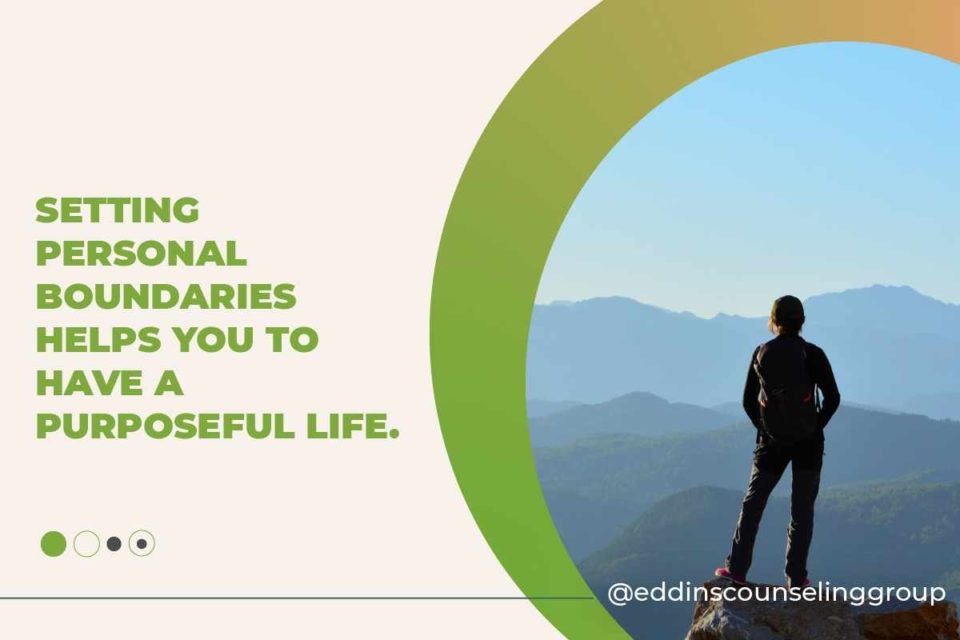
Healthy Relationship Boundaries Includes Understanding Responsibility
Setting boundaries is about determining what is important for you and you alone. It does not include deciding what is important or should be important for others. We may wish others would do things differently, but healthy boundaries is about focusing on ourselves. Healthy boundaries include respecting the choices and decisions that others make as well.
Relationship boundaries also include our beliefs about and actions towards others. Teasing, sarcasm, name-calling, yelling, one-upping, lying, passive-aggressiveness, blaming, interrupting, giving unsolicited advice, telling others what to think/do or what they do/don’t think, are examples of relationship boundary violations.
What is Motivating Your Need to Set a Boundary?
In order to set healthy boundaries in relationships with others, we also have to be mindful of our motivations. This is where knowing your values can help. Setting personal boundaries helps you to have a purposeful life.
It is possible that setting a boundary may hurt someone in the short-term, though not harm them. Especially if they are used to you saying yes and now you say no to their request.
Setting a boundary can lead to disappointment. That doesn’t mean it’s wrong as long as you are consistent with your values and not judging or harming someone else. On the other hand, if the motivation for the boundary request is related to anger, resentment or fear, it is not motivated by the need to set a boundary.
Identifying Your Relationship Boundaries
First consider the thoughts you have about the situation. Thoughts are our perception about what is actually happening. They are our reality, but not necessarily the other person’s reality. Thoughts are not facts.
What emotions are you having in response to the situation? Based on your thoughts and emotions, what, if anything, do you want to do about it? If you don’t ask for what you want/need, you forfeit the right to be angry and resentful when you don’t get it. We can’t expect others to simply “know”, we have to communicate our needs explicitly.
Consider the following prompts to help you identify your relationship boundaries:
- People may not … (i.e, criticize me in front of others, go through my phone).
- I have the right to ask for….
- To protect my time and energy, it is ok to….
Practice Setting a Healthy Boundary
Learning to set healthy boundaries takes practice. It’s a skill and like most skills, you have to try it repeatedly until it comes more easily. Don’t expect this to happen on the first try! When setting a boundary, it should be fairly equivalent to the seriousness of the issue.
All relationships need boundaries. That includes romantic relationships, relationships with other adults as well as our relationships with children. The same guidelines apply to setting boundaries in all types of relationships.
How to Establish Personal Boundaries:
Try something that seems fairly easy to start with. Ensure you have support accessible after your conversation. Vent strong emotions with a support system or in your journal before having a boundary conversation. You want to maintain a neutral tone.
- Name or describe the behavior that is not acceptable to you.
- Express what you need or expect from the other person in simple and direct terms.
- Do not defend, over-explain, or justify your position.
- When faced with resistance, repeat your boundary.
- Know for yourself what action you will take if the person does not respect your boundaries. If you give in, you invite others to ignore your needs. You need to be 100% sure that you are willing to follow through.
- Follow through with the boundary if it is broken. (This is one of the most difficult aspects of boundary setting!)
Examples of healthy boundary statements:
“You may not yell at me. If you continue, I will leave the room.”
“Although this is important to me, I need to decline your request for volunteer help to honor my family’s needs.”
“I’ll have to sleep on it; I’m not ready to make a decision.”
“I won’t be lending you money anymore. I love you and need you to take responsibility for yourself.”
These tips on assertive communication or how to communicate assertively can help you frame your request in a way that is respectful to yourself and others. Assertive communication is a healthy relationship boundary.
Common Challenges in Setting Relationship Boundaries
1. Fear
Sometimes what feels like a healthy relationship boundary is actually a preference based on fear. Fear leads to controlling behavior, which is not healthy relationship boundary setting. Remember, that a healthy boundary includes respecting the needs and wishes of others.
Telling someone what to eat or not eat, is not a healthy boundary. Rather, it’s fear-based (and thus, controlling). As is avoiding expressing your own needs for fear of the other’s reaction. Black and white thinking is another fear-based reaction. For example, “if I set a boundary I may as well say goodbye to that friendship.”
2. Disagreements
Others may not like or agree with your boundaries. This can be very uncomfortable. Healthy relationships allow room for disagreement and respect for each other’s boundaries.
3. Misunderstandings
If others have weak boundaries, it can be difficult for them to respect yours. Misunderstandings can also occur if you haven’t properly communicated your boundary.
4. Expectations
Expectations are not the same as contracting with someone. We can feel let down when we treat expectations like contracts. An expectation is an idea we create based on our own thoughts or information from others. Expectations don’t lead to boundary violations. A contract is an explicit agreement, (ie., committing to meet someone). Breaking the contract (not showing up) is a boundary violation.
5. Ultimatums and Demands
A boundary expresses what one will not tolerate in the relationship. An ultimatum is a threat or an attempt at punishment. A demand assumes we have control over another person, which we do not.
6. Emotions
Be mindful not to take out your frustration onto others, or one-upping anyone. You want to be able to communicate calmly when setting your boundaries.
Grounding techniques and self soothing skills can help you regulate emotions when they feel overwhelming.
7. Saying No
Saying no can be one of the most difficult skills to implement. We may fear the loss of respect, love, or career when we say no to someone. Follow these guidelines when saying no:
- Be honest and direct.
- Don’t make excuses.
- Remember that saying no shows self-respect.
8. Feeling Guilty
Feeling guilty setting personal boundaries is a sign that you need to strengthen your self-worth and self-care skills. This can take some practice. You may also have to work on tolerating uncomfortable emotions. It can feel uncomfortable to set boundaries. Others can respond with disappointment, anger or resentment.
How to Gain Confidence in Setting Healthy Relationship Boundaries
Know Your Rights! I have the right to…
- Not have others tell me what to think, feel or do.
- My own thoughts, values and beliefs.
- Share with others based on what feels right to me.
- Tell anyone who is hurting, abusing or disrespecting me to stop.
- Love myself, respect myself and stand up for myself.
- A relationship that feels good.
- To be me.
- Live the way I want to live as long as I’m not hurting anyone.
- Not be what someone else wants me to be.
- Accept myself and where I am right now.
- Be imperfect.
- Be treated with dignity, compassion and respect.
- Express my feelings, both positive and negative, in a responsible manner.
What are Emotional Boundaries?
All emotions are helpful, whether they are positive or negative. Emotions can also provide us information about our boundaries. For example, anger is a strong signal that one of our boundaries have been violated.
However, the way we handle our emotions is a boundary. Reacting to an emotion can be an expression of an unhealthy relationship boundary. Responding to emotion can lead to healthy boundary expression. For example, if you do feel anger, reacting could lead to yelling or name calling, which are unhealthy boundary expressions. Responding could lead to healthy expression of your boundary by recognizing the reason for your anger and asking for what you need.
Responding to emotion effectively involves the following steps:
- Recognizing that you are having an emotional response.
- Understanding what your emotional response is and describing your feelings.
- Accepting your emotional response (rather than rejecting it or reacting).
- Utilize strategies to reduce the intensity of your emotions when needed.
Once you are more confident in recognizing and experiencing your emotions, you can work on expressing them with others.
What are Physical Boundaries?
It’s important to recognize your own physical boundaries and how those may be violated in relationships with others.
According to Pia Mellody, the following are considered physical boundary violations:
- Standing in another person’s personal space without his/her permission.
- Touching a person (or their cute baby, or baby bump) without his/her permission.
- Being physically abusive in the presence of others.
- Getting into a person’s belongings and living space such as one’s purse, wallet, mail, and closet without his/her permission.
- Listening to a person’s personal conversation or telephone conversations without his/her permission.
- Accessing a person’s telephone records or an email account without his/her permission.
- Not allowing a person to have privacy or violating a person’s right to privacy.
- Exposing others to a contagious illness.
- Smoking around nonsmokers in an identified nonsmoking area.
- Breaking/throwing things in the presence of another person.
- Physical posturing that is threatening or intimidating.
- Domestic violence.
What are Sexual Boundaries?
- Engaging or touching a person sexually without his/her permission.
- Insisting on having your way sexually in the face of another’s “no”.
- Ridiculing or shaming a partner for his/her sexual preferences or boundaries.
- Demanding unsafe sexual practices.
- Exposing others to sexual experience without his/her permission.
- Making comments about another’s physical appearance that are objectifying or demeaning.
- Sexually shaming another person.
- Bringing sexualized comments or humor into conversations inappropriately.
What to Do When a Boundary Has Been Violated
When a boundary has been violated, the person whose boundary was violated should make a request for repair. Let’s say you and your partner agree to a budget. One of you exceeds the budget. An example of repair could be returning the items purchased in excess or reducing the budget for the following period.
If the boundary is violated repeatedly, you need to consider what steps need to be put into place to get your needs met.
If exceeding the budget continued to be a problem, you may need to identify alternate solutions. Perhaps you use designated accounts, cash only, or independently take action to protect yourself. However, repeating the request again and expecting the other person to be different is not effective. This isn’t truly setting a boundary. You have to increase your own self-care and self-protection in response to the repeated violation.
Learn & Practice Healthy Relationship Boundaries
A relationship therapist can help you learn how to identify your needs and communicate effectively in relation with others. Through relationship counseling for one, you can improve self-esteem, set healthy boundaries with others, and establish realistic expectations for yourself and others.
Relationships can be challenging, Despite your best intentions, you may find it difficult to implement boundary-setting skills. Your relationship attachment history can also impact how comfortable you are with setting boundaries with others. Working with a therapist can help you understand your own attachment history and how you can build secure, loving relationships in the present.
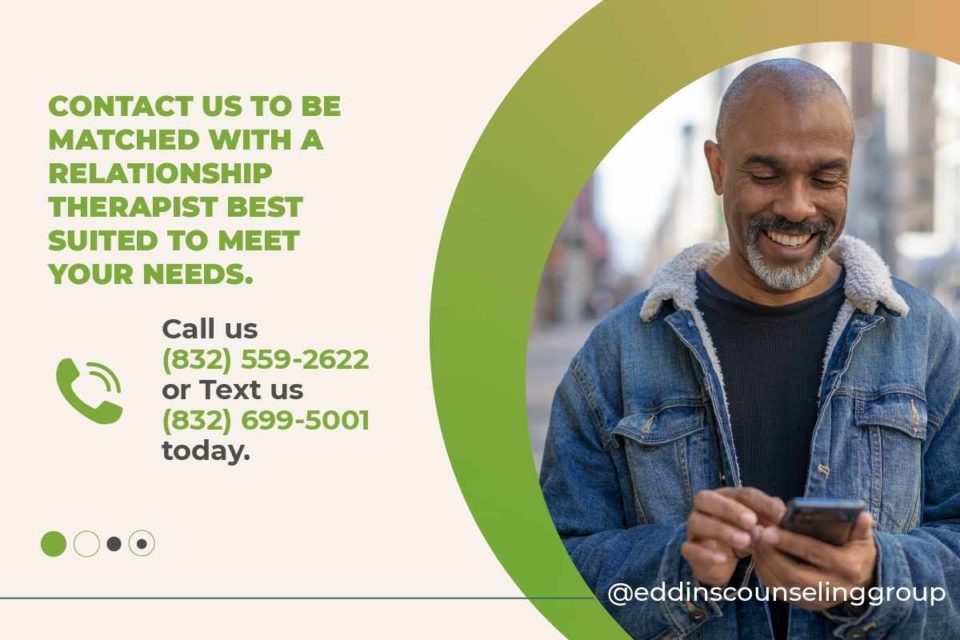
Contact a Therapist For Relationship Support
Contact us to be matched with a relationship therapist best suited to meet your needs. If you are having a hard time setting boundaries with your partner, you may want to explore couples counseling to learn effective communication skills and find areas you can agree on.
Give us a call at 832-559-2622, schedule a free consultation, or book an appointment online. Our therapists in Houston are available to meet with you in person or online.
Grounding & Self Soothing
Get instant access to your free ebook.


